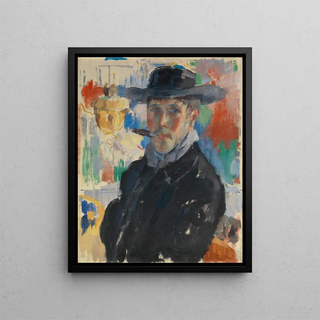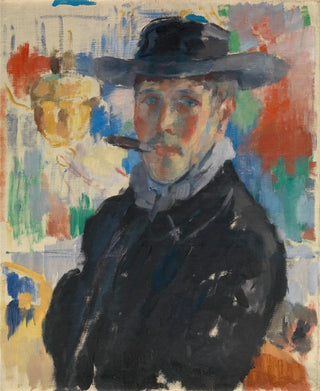Art print | Self-portrait with cigar - Rik Wouters


View from behind

Frame (optional)
Reproduction Autoportrait au cigare - Rik Wouters – Engaging Introduction
The Autoportrait au cigare by Rik Wouters is a piece that transcends mere introspection. In this canvas, the Belgian artist reveals himself with a boldness that instantly captures the viewer's attention. Wouters' penetrating gaze and nonchalant posture evoke a certain confidence, almost provocative. The cigar, an iconic accessory, becomes a symbol of a complex personality, oscillating between creative genius and inner turmoil. This work, far more than a simple self-portrait, is an invitation to delve into the inner universe of an artist in search of himself.
Style and uniqueness of the work
Rik Wouters' style is characterized by an expressive and colorful approach, typical of the post-impressionist movement. In the Autoportrait au cigare, dynamic brushstrokes and vibrant hues breathe an almost palpable life into the canvas. Light plays a crucial role, illuminating the artist's face while casting shadows that add depth to his expression. The composition, both simple and powerful, allows the viewer to focus on the emotions emanating from the piece. The absence of superfluous details enhances the intensity of Wouters' gaze, creating a silent dialogue between the artist and his audience. This singularity makes the Autoportrait au cigare a centerpiece that continues to evoke curiosity and admiration.
The artist and his influence
Rik Wouters, an emblematic figure of early 20th-century Belgian art, left a mark on his era with his bold vision and distinctive style. Raised in an artistic environment, he was heavily influenced by Impressionist and Fauvist currents, but also developed a unique identity. Wouters explored various techniques and themes, ranging from landscapes to portraits, but it is in the self-portrait that he truly found a powerful means of expression. His work is often perceived as a reflection on identity, anxiety, and the quest for self, universal themes that still resonate today. By adopting stylistic elements from his

Matte finish

View from behind

Frame (optional)
Reproduction Autoportrait au cigare - Rik Wouters – Engaging Introduction
The Autoportrait au cigare by Rik Wouters is a piece that transcends mere introspection. In this canvas, the Belgian artist reveals himself with a boldness that instantly captures the viewer's attention. Wouters' penetrating gaze and nonchalant posture evoke a certain confidence, almost provocative. The cigar, an iconic accessory, becomes a symbol of a complex personality, oscillating between creative genius and inner turmoil. This work, far more than a simple self-portrait, is an invitation to delve into the inner universe of an artist in search of himself.
Style and uniqueness of the work
Rik Wouters' style is characterized by an expressive and colorful approach, typical of the post-impressionist movement. In the Autoportrait au cigare, dynamic brushstrokes and vibrant hues breathe an almost palpable life into the canvas. Light plays a crucial role, illuminating the artist's face while casting shadows that add depth to his expression. The composition, both simple and powerful, allows the viewer to focus on the emotions emanating from the piece. The absence of superfluous details enhances the intensity of Wouters' gaze, creating a silent dialogue between the artist and his audience. This singularity makes the Autoportrait au cigare a centerpiece that continues to evoke curiosity and admiration.
The artist and his influence
Rik Wouters, an emblematic figure of early 20th-century Belgian art, left a mark on his era with his bold vision and distinctive style. Raised in an artistic environment, he was heavily influenced by Impressionist and Fauvist currents, but also developed a unique identity. Wouters explored various techniques and themes, ranging from landscapes to portraits, but it is in the self-portrait that he truly found a powerful means of expression. His work is often perceived as a reflection on identity, anxiety, and the quest for self, universal themes that still resonate today. By adopting stylistic elements from his






